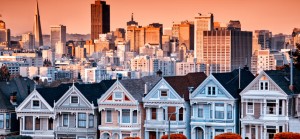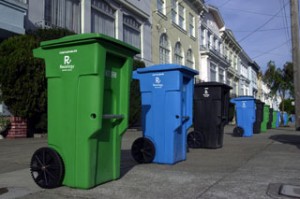By Heather-Ashley Boyer
Introduction
While the sustainability greening movement has made substantial progress in attracting an audience in the US and abroad since its inception in the late twentieth century, cities are still left with the fundamental problem of how to best go about actually implementing environmentally-friendly practices. The answer perhaps resides within capitalizing on the very audience that the movement speaks to as well as developing a clearly defined goal and an appropriate plan. Instead of focusing solely on the development of innovative technology, which can prove to be exceedingly expensive, cities should perhaps follow the lead of San Francisco which has developed an efficient and highly regarded zero-waste program without need for extensive investment. The program has led to reduced city costs, minimalized environmental impacts, and increased city revenue. San Francisco’s city government has ultimately been able to successfully implement its zero-waste program due to effective utilization of recycling capacities of urban residents as well as proper development of an explicitly stated goal and a well-defined plan.
“Pay As You Throw” System
One of the main keys to San Francisco’s success has been a system that encourages residential recycling, known as “pay as you throw” (City Climate Leadership Awards, 2013). In 2009, the city first required that residents sort their waste into the three bins: trash (black), compost (green), and recycling (blue) (San Francisco Department of the Environment, 2013). Known as “the fantastic three”, the system made San Francisco the first city to start widespread curbside collection of food waste and proved to be the precursor to “pay as you throw”( California Department of Resources, Recycling, and Recovery, 2002). This emphasis on city government-enforced diversion developed following a 1996 waste characterization study which revealed that residents were disposing of 200,000 tons of garbage per year, 30% of which was potentially compostable food waste (California Department of Resources, Recycling, and Recovery, 2002). Furthermore, when considering that San Francisco residents have smaller yards than most other areas in California, it became apparent that food discards were a relatively large part of their overall residential waste (California Department of Resources, Recycling, and Recovery, 2002). Thus, incorporating residential food discards, along with yard waste, was a vital step to reaching a 50% diversion rate (California Department of Resources, Recycling, and Recovery, 2002).
Although the pricing system has gone through many changes since then, the current “pay as you throw” collection system is as follows: base rate (per dwelling unit) – $5; 32-gallon blue recycling bin – $2; 32-gallon green compost bin – $2; 32-gallon black garbage bin – $34.08 (San Francisco Department of the Environment, 2013). Aside from this, for each week a resident does not put out a black garbage bin, he/she will receive a 10% discount from the trash portion of the bill (Recology, 2013). The ultimate goal of the system is to encourage residents to abandon their black garbage bins in favor of sorting waste more carefully into recycling and compost. To further emphasize this ultimate goal, the city government has included an even newer rate structure for customers with a 20-gallon black bin, reducing their payment to $24.68, while charges for larger bins will increase in equal amounts for each 32-gallon increase in volume (San Francisco Department of the Environment, 2013). Essentially, the more households recycle in compost, the lower the garbage bill will ultimately be. This financial benefit to residents is largely responsible for driving much of the success experienced in the zero-waste program.
Waste as a Resource
While the “pay as you throw” system has gotten San Francisco quite a bit of mileage in its sustainability efforts, in order to reach a complete elimination of waste, it will be necessary for the city to perhaps redefine the implications of waste and depict it as an important resource. Currently, the city can boast that 80% of trash is being diverted from landfills, in contrast to the 35% national rate (San Francisco Department of the Environment, 2013). Nonetheless, the ultimate goal is for nothing short of 100% diversion by 2020 (City Climate Leadership Awards, 2013). Since residents are still throwing lots of compostable and recyclable materials into their garbage bins, properly sorting these can increase diversion rate from 80% to 90% (San Francisco Department of the Environment, 2013). Arguably the most difficult part of achieving 100% zero waste is the final 10% which goes beyond the simple, sustainable practices of proper sorting.
In order to reach zero waste in San Francisco, the concept of waste will ultimately need to be redefined as a key resource. What is considered garbage by most people is actually nearly all compostable, recyclable, or recoverable; very few used products are truly waste (Recology, 2013). Only hazardous materials or mixed recoverable materials are truly waste. Even though some items such as latex gloves, non-recyclable plastics, snack packaging, and other complex materials were not designed to be recycled, they can still be “recovered” if not contaminated with municipal solid waste (Recology, 2013). These items can be put to good use in artwork as well as in other inventions. Thus, one of the keys to eliminating all waste resides in changing perceptions of waste so that it is seen as a potential untapped resource. This can perhaps be best done by increasing education of the public on the uses of waste. City officials have been known to make in-person house calls to ensure that residents are knowledgeable about recycling, which has likely contributed to the city’s success thus far and will probably continue to do so (Michels, 2013).
In addition to increased consumer responsibility and changes in residents’ perception of waste, other changes will have to transpire on the production level as well. In order to reach a closed-loop material system, the city government will need to partner with producers who design better products and take responsibility for the entire life cycle of a product, including the processes of take-back and recycling (San Francisco Department of the Environment, 2013). Once this is accomplished, there will be more recycled and recyclable goods for consumers to purchase.
Conclusion
As with many topics related to urban planning, the zero-waste program has its promises as well as its pitfalls. While San Francisco has made great strides in its overall sustainability, some critics suggest that certain statistics pertaining to its zero-waste program are not entirely reliable or have been exaggerated (Michels, 2013). Nonetheless, the program still effectively sets a new standard for other cities, both abroad and within the United States. Much of its success can perhaps be largely attributed to its clear-cut goal of eliminating all trash by 2020 through a closed-loop material system. Even if this is not able to be fully accomplished, the city has already reached 80% diversion, which is more than double the national rate (San Francisco Department of the Environment, 2013). Furthermore, this was able to be done without the use of expensive technology and largely was due to a focus on educating residents and encouraging them to practice proper waste disposal. Although cities are limited in their resources to varying degrees, the zero-waste program provides a great model for how other cities can and have achieved similar results.

San Francisco residential areas with city skyline in the background.
Source: City Climate Leadership Awards.
References
California Department of Resources, Recycling, and Recovery. (2002) Case Study: San Francisco Fantastic Three Program. CalRecycle. Retrieved October 23, 2013 from <http://www.calrecycle.ca.gov/LGCentral/Library/innovations/curbside/CaseStudy.htm>
City Climate Leadership Awards. (2013) San Francisco: Zero Waste Program. City Climate Leadership Awards. Retrieved October 23, 2013, from <http://cityclimateleadershipawards.com/san-francisco-zero-waste-program/>
Haley, R. and J. Macy. (2011) Case Study: Zero Waste Program. C40 Cities: Climate Leadership Group. Retrieved October 23, Oct. 2013, from <http://c40.org/c40cities/san-francisco/city_case_studies/zero-waste-program>
Michels, S. (Producer). (2013, January 25). San Francisco on Track to Become Zero Waste City. PBS Newshour. Podcast retrieved from <http://www.pbs.org/newshour/bb/climate-change/jan-june13/recycling_01-25.html>
Recology. (2013) Zero. Recology San Francisco. Retrieved October 23, 2013, from <http://www.recologysf.com/index.php/for-community/zero>
San Francisco Department of the Environment. (2013) Zero Waste. San Francisco Environment. Retrieved October 23, 2013, from <http://www.sfenvironment.org/zero-waste>
Zero Waste San Francisco. (2013) Zero Waste. San Francisco Zero Waste Rates. Retrieved October 23, 2013, from <http://www.sfzerowasterates.com>


